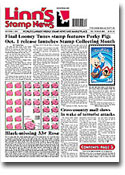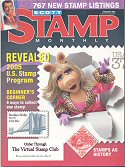
 |
Gloom, Doom and the Future
And
What You Can Do To Affect It
By John M. Hotchner
 My eye was caught by a Letter to the Editor in the January, 2005 issue of the American Philatelist of the American Philatelic Society. (If you aren't a member you should be!) The letter writer, Robert Greenwald of Melville, New York, laments: "...hasn't anyone else noticed that the number of serious philatelic publications has dwindled drastically? Linn's pages are down; Stamp Collector is gone; and Scott Stamp Monthly has been dumbed down so that it now appeals to the type of 'collector' who puts three sheets of Elvis stamps into his safe deposit box to pay for his kid's college tuition...."
My eye was caught by a Letter to the Editor in the January, 2005 issue of the American Philatelist of the American Philatelic Society. (If you aren't a member you should be!) The letter writer, Robert Greenwald of Melville, New York, laments: "...hasn't anyone else noticed that the number of serious philatelic publications has dwindled drastically? Linn's pages are down; Stamp Collector is gone; and Scott Stamp Monthly has been dumbed down so that it now appeals to the type of 'collector' who puts three sheets of Elvis stamps into his safe deposit box to pay for his kid's college tuition...."There is so much to disagree with here that I wonder where to start. Perhaps with a disclaimer: It is considered by some these days to be bad form to comment in one journal on the content of another. But I will, in the glorious tradition of the late 19th and early 20th century, when such commentary — usually heavily negative — was expected. For the most part I don't expect to be negative; except as regards the quoted letter.
First, has the number of serious philatelic publications dwindled drastically? Depends upon how you define "serious philatelic publication" and "drastically;" and what time period one is contemplating. If you consider that Stamp Collector was a serious philatelic publication, then it, as one of two 10,000+ principal weeklies, represents a loss of 50% in the number of large weeklies. (It was weekly; then went to fortnightly; then bit the dust.) That is drastic. But with no prejudice, I would not call Stamp Collector a "serious philatelic publication;" a term which I take to mean one that is principally devoted to the study of fairly narrow slices of the collecting realm.
 Subscribe Now |
 Subscribe Now |
So, the market is changing. Yet serious philatelic publications are in fact alive and well, and in some respects expanding. National level specialist societies have been hit by the same dynamic of "flight to the freebies." Some have lost membership. Yet there are new societies regularly being formed, and they all continue to churn out journals and studies done by serious philatelists for serious philatelists. If you are not a member of one or more, I recommend memberships as a wonderful investment in knowledge. Membership will cost you the equivalent per year of one visit of a family four to McDonald's.
Is Linn's down in the number of pages? Yes, because advertising down. Ads are down because collectors are not the only ones flocking to the Internet. But there is still plenty of editorial content, and it is still varied and serving a wide range of expertise and interest.
Now about the "dumbing down Scott Stamp Monthly;" this is where I find myself really annoyed with the letter-writer. Full disclosure is that I write for Linn's weekly, and SSM is owned by the same company that owns Linn's. I am by any measure an advanced collector in some areas; one who knows better than to put my savings into U.S. Elvis Presley commemoratives. But I gotta tell you that as a reader of SSM for nearly 50 years, I think its new format is terrific: an excellent read, with excellent scholarly material on U.S. philately regularly among its offerings. The fact that it has gone slick with more color and games and activities in no way diminishes its attractiveness for a serious philatelist; and it plays to what the public has come to expect of magazines. In other words, SSM has increased its chances of survival by adapting to the market. I think it is unfortunate that the letter writer sees that as "dumbing down" the magazine.
The tragedy, from my perspective, is that very few collectors (as a percentage of the hobby) take advantage of the education and entertainment in the excellent stable of today's printed periodicals. And am I sad that the Internet is making it harder and harder for print periodicals to compete? Does this mean we should all throw in the sponge? Absolutely not. As with every other aspect of our lives — think back 10 and 20 years and reflect — philately is changing: What we collect, how we collect, where we go to get our stamps, where we go to get our information, where we go to get our stamp supplies, our expectations of how we should be catered to, and more. Those are dynamics that we can and should adapt to as collectors — in our own interest.
But we also need to think about where we put our discretionary dollars and effort in terms of the support we show for hobby institutions that help to preserve and inform our future. I am asking that you give some thought to what hobby institutions you think ought not to die, and what you can do to help them live. Subscriptions and memberships are certainly one way to help preserve those resources. But writing for them, and telling your philatelic friends about them, and taking an officer position or committee chair can also be a great contribution.
The point is that we have the power to shape our world.
 *Regarding joining the APS, don't let the words "Society" or "Philatelic" scare you. The 46,000+ members run the gamut of expertise from beginner to professional. The APS has activities, services and resources for everyone; the principal one being the monthly American Philatelist, which is worth the price of admission all by itself. If what you learn from reading the AP does not save you the $30 membership dues in the knowledge you gain each year, you aren't trying! Write to the APS for additional information at 100 Match Factory Place, Bellefonte, PA 16823.
*Regarding joining the APS, don't let the words "Society" or "Philatelic" scare you. The 46,000+ members run the gamut of expertise from beginner to professional. The APS has activities, services and resources for everyone; the principal one being the monthly American Philatelist, which is worth the price of admission all by itself. If what you learn from reading the AP does not save you the $30 membership dues in the knowledge you gain each year, you aren't trying! Write to the APS for additional information at 100 Match Factory Place, Bellefonte, PA 16823.Should you wish to comment on this editorial, or have questions or ideas you would like to have explored in a future column, please write to John Hotchner, VSC Contributor, P.O. Box 1125, Falls Church, VA 22041-0125, or email, putting "VSC" in the subject line, at jmhstamp@verizon.net.